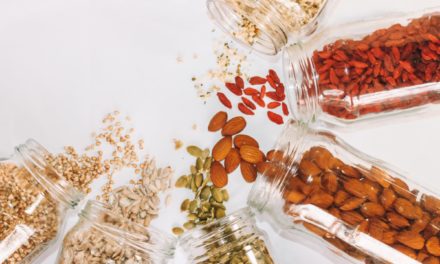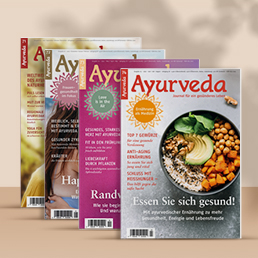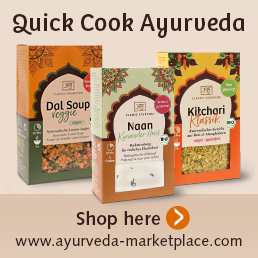Warm milk with honey. As a child, this was the nightcap that led me to the land of dreams. The cows were next door in the pasture and fed exclusively on lush grass and healthy herbs. In the evening, they came to the stable to be milked. The village beekeeper provided us with honey.
Ayurvedic connoisseurs know that warm cow’s milk has a calming, cardio-strengthening and nourishing effect. Fresh organic milk is considered a valuable food in ayurveda, which promotes sattva in the mind; a food that clears the mind, empowers compassion and supports stress resilience. Also, milk is one of the so-called rejuvenating remedies, the rasayanas. In general, a sattvic diet consists of high-quality, fresh and nutrient-rich food (e.g. from organic production; canned food, warmed-up remains and microwaved food is considered dead) and its loving preparation and consumption in a pleasant atmosphere.
In the sattvic diet, meat, fish and eggs are strictly avoided so that the only sources of animal protein are milk and dairy products. The principle here is that the more milk or its products are heated and processed, the more their sattvic qualities are lost. Hormones and antibiotics also damage the milk quality and make it less digestible. For this reason, favour organic raw milk and its products from your region, from animals kept under species-appropriate conditions.
Which milk product suits me?
Cow’s milk
Cooked, warm, fresh organic milk from a regional farm is an excellent sedative for all vata physiques. It promotes natural intelligence and is extremely useful for mental stability. Warm milk balances all doshas but should only be consumed in small amounts if there’s a lot of kapha.
Cold milk can be harmful. Due to its oily and heavy properties, it can clog the circulation channels and congest the body. This aggravates many chronic diseases such as asthma, rheumatism, allergies, arthritis or heart diseases. This effect is reinforced by the adverse combination of milk with other foods. Milk should not be combined with meat, fish, eggs, sour fruits, yoghurt or salty foods. Milk and dairy products are well suited to sweet, unsulphured dried fruit, starchy vegetables, legumes and whole grains.
The mucus promoting properties of milk can be neutralised with spices such as cardamom, ginger, cinnamon and turmeric. Other spices such as ashvagandha, shatavari, comfrey root and ginseng enhance the rejuvenating properties of milk.
Cream
Cream is the layer that collects on top of untreated milk. It contains 25-33% fat. Cream has sattvic qualities which, however, as with milk, are greatly reduced by various methods of preservation such as UHT, sterilisation or the addition of the thickening agent carrageenan. Since it is “heavier” than milk, it is unsuitable for people who have a lot of kapha and a weak digestion.
Buttermilk
It is made from cream during the buttering process by separating it into fats, the butter and its fat-free components, the pure buttermilk. It is easy to digest, dry and slightly warm. It calms kapha and vata. It is healing, ideally suited for the treatment of gastrointestinal disorders.
Butter
Butter consists of at least 80% fat. Butter is good for people with a strong digestion and a lot of internal heat (pitta types). When melted, it is the most digestible. Too much butter can clog internal circulation channels and increase cholesterol levels.
Ghee
Ghee (clarified butter, concentrated butter) consists of almost 100% pure fat. It is a sattvic food, easily digestible and pure. Ghee is one of the 10 foods that should be consumed daily. It penetrates to the finest cell level, has a detoxifying, cleansing, rejuvenating, regenerating, anti-inflammatory and invigorating effect on the immune system. Ghee cools pitta, calms vata and in moderation is also suitable for kapha. Over-consumption leads to a blockage of the body channels and weight gain.

Yoghurt
Yoghurt is made from milk mixed with lactic acid bacteria through fermentation. Yoghurt, therefore, is sour. Especially in combination with citrus fruits, tomatoes, berries or bananas, it disturbs pitta, blocks the circulation channels, forms ama (metabolic waste) and often leads to skin irritation and inflammation. Thus, the classic breakfast of cereal with yogurt and fruits is a bad idea.
The best way to consume yoghurt is to make a lassi (yoghurt and water in equal parts with herbs) or as raita, the yoghurt salad, that is part of most Indian meals. The lightness of the cucumber lifts the heaviness of the yoghurt. It is made lighter by spices such as coriander, cumin or cayenne pepper. Yogurt is mainly recommended for vata types.
Sour cream/creme fraiche
These are lactic acid, bacteria-added cream products of different fat levels. Due to their acidic properties, like yoghurt, they can aggravate inflammatory (pitta) conditions, including ulcers, fever and infections. These products are best suited for vata types.
Cheese
Cheese is heavy, oily and sticky. It can aggravate arthritis, gout, infections, acne, colds, ulcers and lung disease and increase cholesterol levels. The more fermented and salted the cheese is, the harder it is to digest and the more it bothers pitta and kapha. Pitta especially is disturbed by the combination of cheese with citrus fruits, tomatoes, berries or bananas. Circulation channels are blocked and ama is formed. Young, mild, sweet-tasting cheeses are generally preferable. Hard-to-digest cheeses can be made lighter with spices such as mustard, cayenne, black pepper, horseradish and cumin.
Paneer, the self-made and commonly used cheese in India, is easily digested, as is cottage cheese. It is cool, nutritious and high in protein. Cream cheese is a bit stickier, but still easier to digest than regular cheese.
Alternative for cow’s milk intolerances
Anyone who has problems with the digestion of cow’s milk and products and who is suffering from asthma, coughs or other illnesses associated with mucus can try goat’s milk as an alternative. It has astringent, sweet, cooling and light qualities and has a balancing effect on all doshas. It is, therefore, also suitable for people suffering from coughs, asthma, mucus, fever, diarrhoea and oedema. Optimally, it should be taken warm and with spices.
Get the best out of milk products by considering the following points:
1. only fresh, untreated organic milk from your region
2. in small quantities,
3. warm and
4. with the right spices.
Then milk will fully unfold its cell-rejuvenating anti-aging effect and its effects on your mind!

 Tatjana Zlatkovic / Stocksy United
Tatjana Zlatkovic / Stocksy United 












